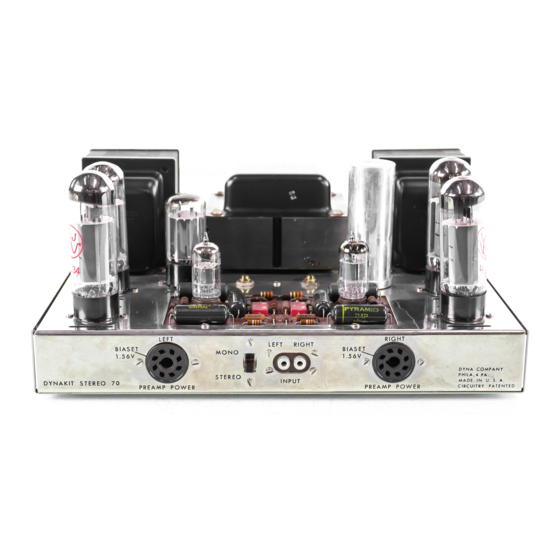DYNACO Stereo 70 Anweisungen für die Montage - Seite 4
Blättern Sie online oder laden Sie pdf Anweisungen für die Montage für Verstärken DYNACO Stereo 70 herunter. DYNACO Stereo 70 16 Seiten. Series ii tube amplifier
Auch für DYNACO Stereo 70: Handbuch zur Wiederherstellung (20 seiten), Handbuch zur Wiederherstellung (5 seiten), Benutzerhandbuch (12 seiten)

gun, long nose pliers, screwdriver, and wire
cutters.
Although not essential, a low cost wire
stripper and cutter of the type which can be pur-
chased for less than $1.00 will greatly facilitate
cutting and stripping the various leads in the kit.
Good soldering technique is valuable in obtain-
ing sat i s f act
0 I'
Y results from any electronic
equipment.
ALL SOLDERING MUST BE DONE
WITH ROSIN CORE SOLDER.
There is no war-
ranty on any equipment in which acid core solder
has been used. Make sure that the solder used is
plainly marked "Rosin Core."
If
you have solder
on hand the origin of which is doubtful it is wise to
obtain new 50/50 or 60/40
l'
a sin core solder.
Whenever sol del' in g is required, the assembly
instructions specify it by "(S)."
If
this symbol is
not shown aiter a connection is specified, it indi-
cates that further connections will be made at that
point before soldering.
Soldering is accomplished by heating the joint
with the iron until solder is hot enough to flow
when touched to the joint.
It is
not desirable to
feed the solder to the iron. It should be fed to the
junction of iron and joint. After the solder flows,
the iron should be held in place for a few seconds
and removed when it is seen that the solder has
contacted both parts of the connection - the lug and
the wire to which it is connected.
It
should not
show a ball of solder but a smooth transition from
solder to component lead.
Before a p ply in g solder the joint should be
clean and the lead should be crimped in place so
as to have mechanical security.
It
is not neces-
sary to wrap leads around contacts many times. A
single turn and pinching together with long nose
pliers is suitable.
After soldering, there should
be no play at the joint if the lead is wiggled with a
pair of plie rs. It is practical to do all soldering
with a pencil type iron of low wattage rating. A
small tip is extremely useful when working in a
confined space.
If
a solder ing gun is used, it
should be used with discretion since the amount of
heat available is far more than
l'
e qui red for
soldering light wires.
Component leads should be trimmed as they
are used; the length should be such that the proper
connection can be made from point to point without
strain on lugs or components.
Care should be
exercised not to allow wires to touch one another
unless they are actually connected to the same
point.
The ins t
I' U
c t ion s which follow have been
arranged for simplified procedure in which the
work can be done without interference between the
various portions of the wiring.
It
is recommended
that the instructions be followed on a step by step
basis, checking off each stage as it is completed.
The pictorial diagrams should be used for refer-
2
ence and all connections checked against these
before going on to the next stage.
If
the wiring is
done methodically and each step checked carefully,
your amplifier should work without difficulty as
soon as it is completed.
MECHANICAL ASSEMBLY
PICTORIAL DIAGRAMS SHOULD BE CONSULTED
DURING ALL PHASES OF ASSEMBLY
1 ("I) Mount the seven octal sockets with 4/40
hardware (the smallest screws supplied).
Note that there is a small slot or keyway in
the center hole of each socket; be sure in
each instance that this keyway is properly
oriented as shown in the pictorial diagram.
Insert screws from the top of the chassis
and mount the sockets from the bottom.
Fasten with nuts and lockwashers.
2
(0
Place the bakelite insulator over the front
of the two socket input connector and mount
the combination from the inside of the
chassis using 4/40 hardware.
3
(II)
Mount the SPDT slide switch (with three
lugs) next to the input connector. No nuts
or lockwashers are necessary since this
item has threaded holes.
4 (.;) Mount the two four screw terminal strips
on the c has sis rear from the outside.
Fasten with 4/40 hardware.
5
(v')
Mount the two 10,000 ohm potentiometers
in the 3/8" holes near the center of the
chassis.
Locate with the three connecting
lugs facing the front of th,: chassis.
Put a
3/8" lockwasher on each shaft, insert from
the inside, and fasten with a 3/8" nut.
6
(0
Fasten the long 4/40 screw between the two
potentiometers with a 4/40 nut. Then place
the selenium rectifier over the screw. The
lug marked
(+)
should be closest to the
chassis and both lugs should face the rear
of the chassis.
Fasten with 4/40 lock-
washer and nut.
7
(J)
Mount the rubber grommet in the 3/8" hole
in the cente
l'
of the rear
fl
a n g e of the
chassis.
8 (/). Mount the fuse post in the D shaped hole in
the rear of the chassis. The rubber washer
goes between the chassis outside and the
shoulder of the fuse post.
Fa s ten with
special nut provided.
